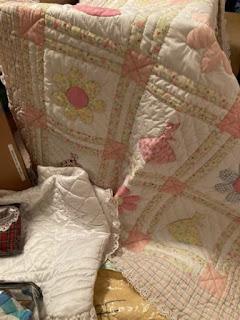
Family Heirlooms
Photo by Karen D. Austin
Life can be cold and hard edged, so I love to surround myself with sheets, blankets, and quilts. I also have a lot of towels for the bathroom and kitchen, but today I am thinking about quilts. We own several store-bought items, but I feel especially comforted when I snuggle up with quilt made especially for me or a member of my family.
My beds usually have layers of blankets, comforters, and quilts on them so that I can burrow into a nest of softness and warmth.
I don't know how to knit, crotchet, quilt, or sew. Consequently, any hand-made items in my house came from one of several women in my extended family--my mother, Donna; my mother-in-law, Linda; my sisters, Julie and Michelle; and my own grandmothers, Thelma, Viola, and Doreen.
Today I was packing up some of these heirloom quilts and thinking about the generation above me. How these women haunt me--in ways that are assuring as well as ways that are a bit unnerving.
I am sure that when these women made these quilts, they thought about binding the generations together as they bound the fabric together. They imagined their children and grandchildren moving into the future with more than shared DNA but some shared values and with a legacy of their love moving on beyond their own lifetime.Today while I was packing up some of these items, I had a hard time imaging the future. My children are not cut from the same cloth as my grandmothers who were rural, church going, family centered people. My children have are urban and defined more by their jobs, friends, and tastes in media than by their ancestors. They do care deeply about civil rights and finding a way to live in a pluralistic, multicultural, global world connected by hypertext media. They don't have much use for the quilts that I have saved for them.
For now, I am going to keep these quilts, but I am thinking about integrating them into my household for everyday use. As I fold and refold these quilts that my children chose not to take with them when they launced as young adults, I am thinking of two pieces of literature. First is William Faulkner's novel Absalom, Absalom! This 1936 novel describes the ambitions of Thomas Sutpen who spends decades rising out of poverty to build up his family wealth and family system so that he is successful by conventional standards. By the end of the novel, however, Sutpen sees his efforts unravel--his wealth depleted, his family dispersed, his homestead in flames. All his efforts to build a legacy were in vain.
Although I read this novel before my children started elementary school, I am wondering if I failed to heed the lessons of this cautionary tale. Have I focused too much on imaging a future, a legacy for myself that is built on vanity rather than on meaningful relationships with my children in the present? Now that my children are adults, how might I collaborate with them in order to support the future that they are building? Otherwise, I might be sitting in the ruins of a burnt homestead that was a product of my own ego more than a product of being vulnerable to the possibilities that each day presents to me as I walk into an uncertain future.
The other work of literature that I think about is Alice Walker's 1973 short story "Everyday Use." The story centers around the way three women interact with the heirloom quilts from the household they shared before the daughters became adults. One daughter, Maggie, still lives at home with her mother, identified in the story as Mrs. Johnson. The other daughter, Dee, has just returned after being absent from the family home and her hometown for years because she was pursuing an education.
Dee comes home and assertively demands the family quilts, explaining that she understands their value as homespun artistry where Maggie (according to Dee's tone) is too naive to understand their value. Dee wants to take them back to the city and display them on a wall. Maggie wants to put them to everyday use.
The mother usually caves to Dee's bossy ways; however, at the end of the story, the mother pulls the quilts out of Dee's arms and gives them to Maggie who has a more sentimental connection to the women who made the quilts and who has learned how to make quilts so that the legacy will live on rather than being frozen into the past by hanging on a wall.
By thinking of Walker's story, I am not promising to hang these heirloom quilts on the wall. And I am not promising to freeze family history.
OK. Before I write something that sounds grounded and sage, let me be honest, I am wrapping myself up in these quilts and mourning the loss of heritage and tradition. I am stuck trying to decide whether to press my children to take these quilts into their apartments or whether I should box them up and stick them in the back of my closet until they retrieve them--which honestly might be after I die. And even then, they might throw them out or give them to a thrift shop. I have no control over how they will entail their family heritage into their own future lives.
With a little struggle and a bit of grief in doing so, I can learn to accept a future that uses material from the present instead of clinging too tightly only to material from the past--only to have it decay in my closed fist.
But after being sad for another day or two, I will find a way to put these quilts to everyday use, meaning that I will put them in the daily traffic of my life. I am going to use some, display some, and store some within my eyesight so that I can look at all of them regularly. I need to find a way to transform the pain of loss into an opportunity to meditate about intergenerational connections, family legacies, and shared values.
I will never convince my children to treasure these quilts. They are never going to regard extended family through the same lens that I do. (We each have our own generational and individual world views.) However, I can reduce my grief by making different choices. I can stop trying to push my children into my vision of their future and instead find a way to connect with them and support them--even when they change fundamentally from the way their great grandparents, grandparents, and even parents function in the world.

